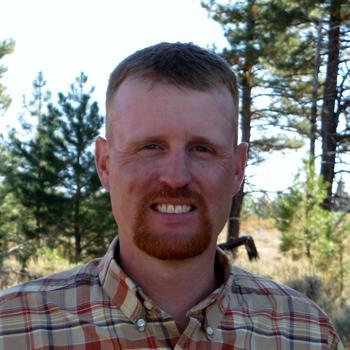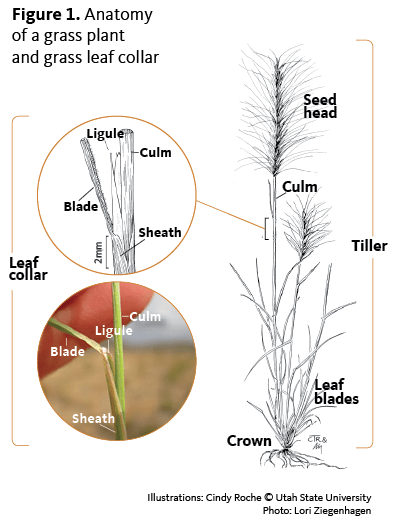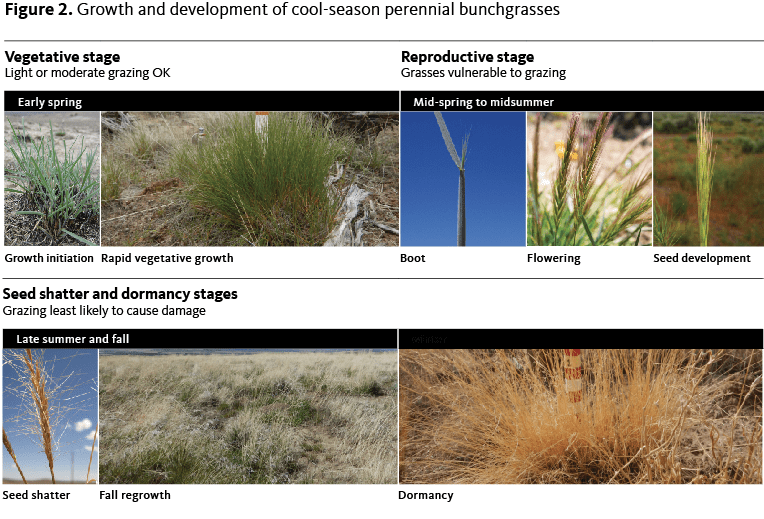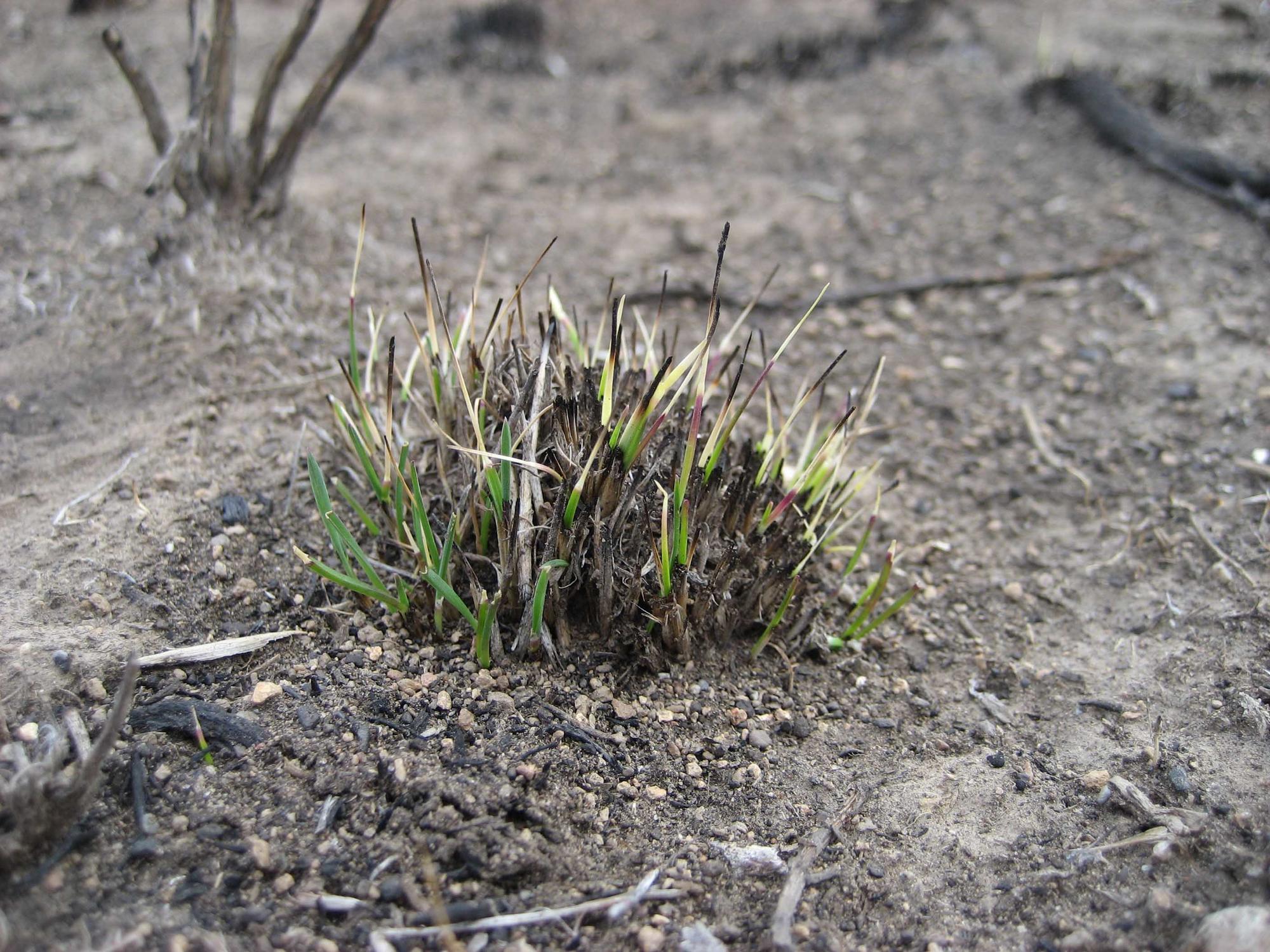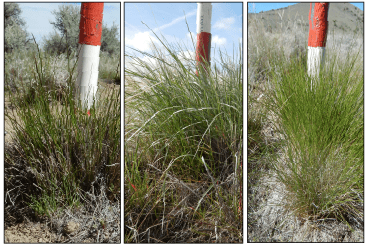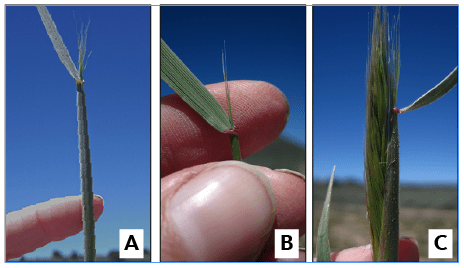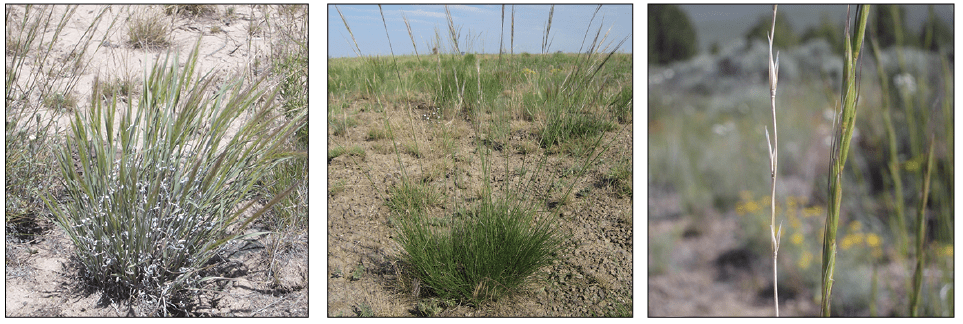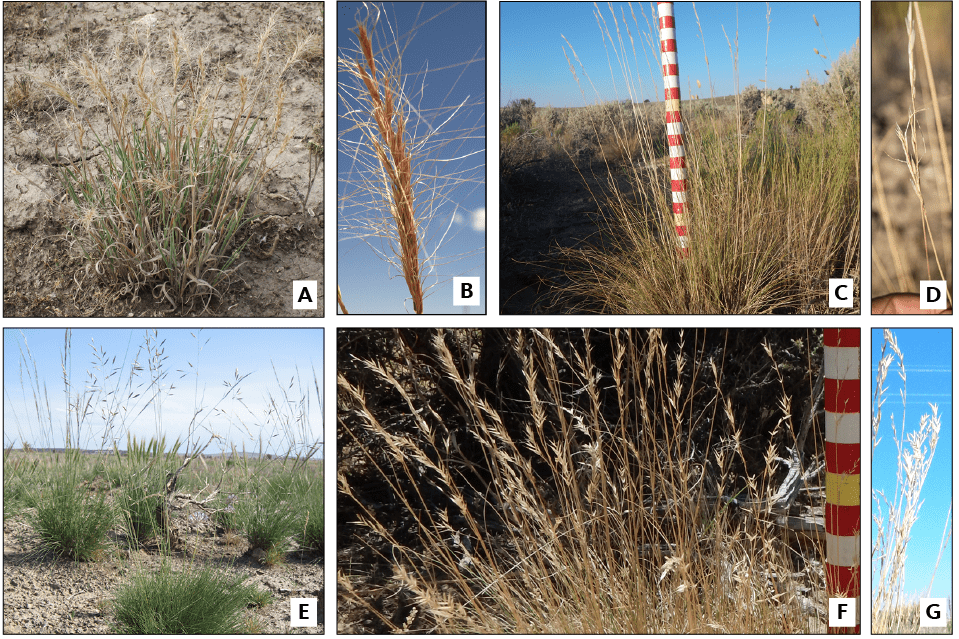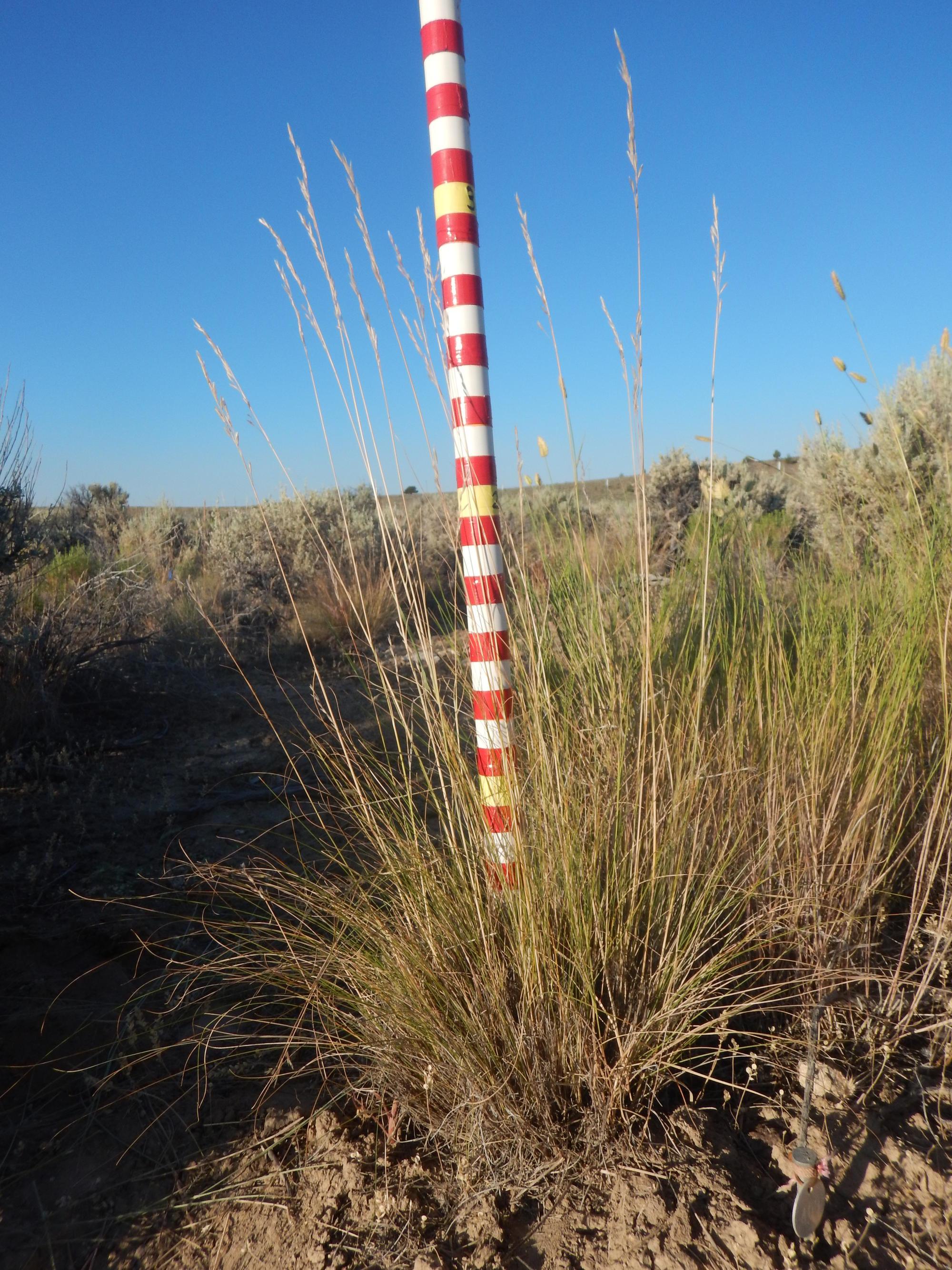The ultimate goal of a successful rangeland cattle operation is to maximize the conversion of forage into beef, year after year. That means producers must sustainably manage vegetation to maintain an operation’s resource base and long-term profitability. Effective grazing management of rangelands relies upon removing only enough plant material to meet the nutritional needs of livestock, while maintaining or improving rangeland health.
The short growing seasons and low precipitation of the high desert region of eastern Oregon limit plant growth, resulting in low productivity. To supply enough forage, grazing operations depend on vast areas of land. Across these large pastures, plant communities differ widely based on varying soils, elevations and aspects. Rangeland vegetation can also vary widely through time in the high desert, where precipitation fluctuates from year to year — from less than 50% to over 200% of the long-term average.
To effectively manage grazing, managers must understand how livestock grazing interacts with plant growth and production in a highly variable environment.
Producers must balance the intensity, frequency, duration and timing of grazing with the variation in vegetation that occurs from one year to the next and across large pastures. They can use stocking density and duration to manage grazing intensity, while rotational grazing strategies can help manage frequency and timing — all key components in grazing management. Managers engage in adaptive management by applying a grazing strategy, monitoring the results, learning from the outcomes and adjusting future management.
To adjust grazing management — whether within a single season or over the long term — rangeland managers need to understand the phenology of key grass species. Phenology refers to the timing of biological events, such as plant flowering, and the processes that alter their timing. Think of phenological stages as the major recognizable phases of plant development. Variability in climate, weather and environmental factors affects plant development.
Knowing which plant stages are most sensitive to grazing — especially when they occur in conjunction with these external factors — can help inform grazing managers. This helps managers determine when to avoid grazing and when more intensive grazing is least likely to cause lasting harm. While there are no hard and fast rules, these guidelines can help improve an adaptive grazing management plan.
Vegetative characteristics of cool-season grasses
A grass plant is composed of multiple units called tillers, or shoots (Figure 1). Each tiller consists of a culm, wrapped in a leaf sheath, and attached leaves. Tillers can be reproductive (stems with flowering parts) or vegetative (consisting only of leaves). Seed heads grow at the top of the reproductive tillers.
The base of the grass plant is called the crown. The leaf sheath wraps around the stiff culms, and a collar forms where it separates from the culm (Figure 1). Within the collar lies the ligule, an extra piece of tissue often lighter in color and more translucent than the rest of leaf. The growing points of reproductive tillers are raised as they grow taller and progress through reproduction and seed development.
Phenology: plant growth stages
Being able to recognize the different parts of a grass plant in order to determine phenological stages helps managers understand at which stages a grass plant is most susceptible to grazing.
A perennial grass plant passes through several phenological growth stages throughout its life cycle (Figure 2). The yearly life cycle begins after grass plants emerge from winter dormancy and begin vegetative growth in early spring. The grass then progressively ramps up growth and resource use through the boot stage as it prepares for reproduction, elevating its growth points.
During the reproductive, or flowering, stage of the plant, the seed heads emerge from the leaf sheath, and reproduction begins. Seed development follows. Once the seeds harden they start to dry out, becoming “ripe.” The grass enters the seed shatter stage, when seeds begin to drop or are scattered by wind.
After the seed ripe stage, the grass plant dries out in the summer heat, and begins preparing for winter dormancy. Fall regrowth, or “green-up,” occurs in some, but not all years, depending on weather conditions. The grass then enters winter dormancy, where it remains alive through use of resources stored in the roots, crown and the base of the stems.
Figure 2 shows the major phenological stages and associated grazing considerations for five cool season forage grass species common to the northern Great Basin.
Growth initiation
Of the five common range forage species highlighted here, bottlebrush squirreltail and crested wheatgrass tend to initiate growth earliest in the spring, followed by Idaho fescue, Thurber’s needlegrass and bluebunch wheatgrass. Aside from the timing of growth initiation, distinguishing between species can be difficult during the vegetative plant stage (Figure 3). The vegetative stage begins in early spring with adequate soil moisture, when warming soil temperatures prompt the emergence of new tillers from the crown.
Rapid vegetative growth
After growth initiation, bunchgrasses enter a period of rapid vegetative growth (Figure 4). The plants capitalize on available spring moisture and warming temperatures to quickly lengthen newly formed leaves. Increasing leaf area captures sunlight, supporting additional growth through energy derived from photosynthesis.
Boot
Following the vegetative stage, stalks elongate and seed heads begin to develop within reproductive tillers. This is the boot stage. The grass draws upon new and existing carbon reserves, micronutrients and water resources as it prepares for reproduction, initiating the growth of the flowering portions of the plant. The developing seed head is enclosed in the plant during the boot stage, forming a bulge at the top of the reproductive stalk.
The boot stage can be identified by running your fingers up and down the stalks of the plant and feeling for the bulge. You can even open the leaf sheaths to see the forming seed head within. During the boot stage, the tips of awns (stiff, bristle-like structures, often growing from the tip of a seed) begin to emerge from the sheath (Figures 5A, 5B).
As the seed head forms within the stalk, it can resemble a leg within a boot. During late boot stage, much of the seed head is visible outside of the sheath, but the seed stalks have not yet begun to flower (Figure 5C).
The boot stage is hard to identify from afar. Because only a portion of a plant’s tillers become reproductive, it’s best to manually probe several tillers of an individual plant for enclosed seed heads.
Flowering
You can identify the reproductive stage of a grass plant by its flowering seed stalks (Figure 6). This stage is usually short-lived, but identifying the flowering stage helps differentiate it from the seed shatter stage, when grazing is less likely to damage the plant.
Seed development
During the seed development stage, the grass directs resources to seed creation. Seeds become visible on reproductive stalks, but remain relatively soft and green (Figure 7).
Seed shatter
As the seed hardens and the stalks dry out, the grass enters the seed shatter stage and completes reproduction for the year (Figure 8). It is no longer highly susceptible to grazing. Aboveground growth ceases, and close grazing (grazing very close to the grass crown, leaving minimal residual material) or repeated grazing does not force the grass to withdraw resources from root reserves. However, managers should ensure that grazing does not remove the basal growth points and that enough stubble remains to protect the crown from extreme temperatures.
Fall regrowth and winter dormancy
In years with warm and wet fall seasons, bunchgrasses can initiate regrowth. During this time, vegetative tillers use stored resources to elongate again, similar to spring growth initiation. If this fall green-up is interrupted — by fire or grazing, for example — the bunchgrasses experience a reduction in stored resources. That could lead to lower production during the next year’s spring growth initiation.
During winter dormancy, grass plants experience no new growth. Leaves and stalks lose their green color and no longer derive resources from the sun and soil, reducing their biological activity. The plants remain alive by relying on resources stored within their root systems and in the crown of the plant, at the base of the tillers.
Grazing recommendations
This guide provides tools to help grazing managers identify the different phenological stages of key forage plants and understand their susceptibility to damage through grazing.
Vegetative stage
Growth initiation depletes the energy reserves of the plant on a temporary basis — for a period of three days or less. This leaves plants vulnerable to damage. As new leaf material emerges, photosynthesis replenishes the plant’s energy.
After growth initiation, grasses begin to grow faster, with increasing leaf area, until the onset of reproduction.
When cattle graze a tiller in the vegetative stage, leaves and stems can rapidly regrow if conditions are right. Regrowth at this stage depends on having adequate soil moisture and recovery time before the next grazing event.
However, heavy or repeated grazing in early spring can result in long-lasting damage. Heavy grazing can damage the crown of the plant, and multiple repeat grazing events can lead to an exhaustion of resources and eventual mortality.
Reproductive stages
In contrast to the vegetative stage, tillers grazed during the reproductive stages do not continue to grow. Growth of tillers stops when grazing removes the growth point or when the grass begins to generate seed heads instead of leaves. A grass plant grazed during these stages must re-start growth from dormant buds in the crown of the plant, developing new tillers in the same resource-depleting process that occurs during growth initiation in early spring. This forces the plant to use resources it needs to survive the winter and initiate spring growth, leading to significant reduction in root and shoot growth the following year.
The strategy referred to as “take-half leave-half,” which entails removal of 50% of a grass plant’s aboveground biomass, does not apply during the reproductive stages. Removal of half the plant during this time frame can lead to an almost complete eradication of reproductive stalks the following year and almost half the regrowth.
Producers should avoid grazing all five of the common range grasses as they progress from the boot stage to seed development each year. But the idea of avoiding grazing entirely during these sensitive stages is unrealistic for most producers. Fortunately, the five species of grasses mature at different times of the year.
Grazing strategies
Several strategies can help land managers plan grazing rotations that largely avoid critical growth periods:
- The first step for any strategy is to identify the dominant, or key forage species for different rangeland pastures.
- Use a combination of rest-rotation, deferred-rotation, and altering turnout times and duration to mitigate some of the damaging effects of grazing during the reproductive stage.
- Provide spring-grazed pastures at least one year of spring rest by deferring grazing until after seed-shatter (deferred-rotation). This provides time for the grasses to recover growth and depleted resources.
- Consider an entire year of rest (rest-rotation) for pastures needing more recovery.
- Change turnout times in response to yearly changes in bunchgrass phenology to help protect bunchgrasses from damage and maximize forage production. For example, in pastures managed with a deferred-rotation, during the deferred year turn-out times should be adjusted to match the plant stage of the key grass species. If seed shatter occurs early, then shift turn-out earlier as well. Similarly, during the spring graze year of the rotation, if bunchgrasses emerge from dormancy earlier, shifting turn-out earlier to make use of the vegetative stage will help utilize available forage.
Strategies by species
The strategies applied depend on the species of grass:
- Bluebunch wheatgrass and Thurber’s needlegrass require longer recovery periods following grazing during sensitive stages than crested wheatgrass, bottlebrush squirreltail and Idaho fescue. A deferred-rotation strategy is one way to help bluebunch wheatgrass or Thurber’s needlegrass pastures recover from grazing during sensitive reproductive stages. This strategy alternates grazing during the growing season in one year with grazing after seed-shatter in another.
- Crested wheatgrass responds more favorably to grazing than many native bunchgrasses, often exhibiting higher production rates under heavier grazing regimes than native species.
- Idaho fescue can tolerate somewhat heavier grazing than other native species during reproductive stages, but repeated heavy use is not recommended.
- For bottlebrush squirreltail, late spring grazing that removes greater than 30% of the aboveground weight of the plant, when the plant is typically in the reproductive stages, has been shown to negatively impact plant vigor over the long term.
While grazing during the boot stage can increase subsequent palatability and nutritional quality in bunchgrasses, it comes at the cost of lost production.
Seed shatter and dormancy stages
Grazing during the seed shatter stage or later typically does not injure bunchgrasses, with the exception of close grazing that penetrates the crown. Deferring grazing in some years until after seed shatter not only allows bunchgrasses a year of recovery, it also provides producers with an indicator of a grass’s response to previous grazing management.
Producers can assess the effectiveness of their strategies by tracking the proportion of reproductive to vegetative tillers — an indicator of plant health — over several years. Plants experiencing heavy grazing during the reproductive stages might produce fewer seed stalks the following year. During severe drought years, grasses may produce fewer reproductive stalks. Occasionally, in harsh years, some of the grasses might not produce viable seed. After severe drought or heavy grazing years, consider a rest period, or defer grazing until after seed shatter. This will promote seed production and allow for recruitment of new grasses during more favorable years.
Grazing during fall or winter typically does not cause lasting damage unless plants are grazed close to the crown. Managers should ensure grazing does not remove the basal growth points and that enough stubble remains to protect the crown from extreme temperatures. However, herbage nutritional value and palatability typically decline during these stages. Thurber’s needlegrass tends to remain greener longer than Idaho fescue into the summer and maintains a slightly higher crude protein than other bunchgrasses when dormant.
Grazing after seed shatter generally has fewer negative effects on bunchgrasses. However, heavy dormant season grazing (to 2" stubble height) of the more sensitive bluebunch wheatgrass may reduce yield the following year by 25%.
Summary of recommendations
Light or moderate grazing during the vegetative stage allows for plant recovery, while grazing during the reproductive stages causes the most injury to plants. Grazing when the plants are in seed shatter or dormant stage is least likely to cause injury. Grazing management is a complex balance of timing, weather, soils, animal behavior and plant phenology. An adaptive grazing management approach that incorporates moderate, rotational grazing and avoids the use of key bunchgrasses during sensitive times year after year is most likely to sustain or improve rangeland health. This can help rangeland managers learn how to identify when key plants are susceptible to damage, and provide strategies that balance rangeland and animal health.
Glossary
Grazing intensity: a factor of grazing frequency, duration and stocking density. Intensity is the cumulative effects of grazing on the plant and is often defined as light, moderate, heavy or severe.
Grazing frequency: how often a pasture is grazed.
Grazing duration: the length of time cattle graze a particular area.
Stocking density: the number of animals per unit area in a pasture at any given point in time.
Season of grazing: the specific time of year or season a pasture is grazed (for example, spring or fall)
Deferred-rotational grazing: the grazing management practice of moving livestock between pastures to avoid grazing one pasture during the same season year after year. Grazing is deferred periodically in each pasture until after grasses set seed. The number of pastures and the time between deferred grazing can vary, but might include grazing a pasture during the spring of one year, and deferring grazing until later in the summer or fall the following year.
Rest-rotational grazing: the grazing management practice of alternating grazing of a pasture with a complete year of rest. Rest-rotational grazing might include three pastures, where one pasture receives spring grazing one year, a full year of rest (no grazing) the following year, and dormant season grazing the third year. This allows for rest every third year.
Phenology: the study of the timing of regular biological events, such as plant flowering, and the processes that alter their timing.
Phenological stages: Stages during plant growth that are a distinct phase of the plant’s development and can be related to management considerations. Phenological stages, or plant growth stages, vary widely in their groupings. For this guide we define phenological stages into three main categories: vegetative, reproductive and seed shatter/dormant. Subcategories include growth initiation, rapid vegetative growth, boot, flowering, seed development, seed shatter, fall regrowth and winter dormancy (Figure 2).
References
Anderson, L.D. 1991. Bluebunch Wheatgrass Defoliation Effects and Recovery: A Review. Bureau of Land Management. Salmon, Idaho.
Cook, C.W. and R.D. Child. 1971. Recovery of Desert Plants in Various States of Vigor. Journal Of Range Management 24:339–343.
Ganskopp, D. 1988. Defoliation of Thurber Needlegrass: Herbage and Root Responses. Journal of Range Management 41:472–476.
Ganskopp, D., T. Svejcar and M. Vavra, 2004. Livestock Forage Conditioning: Bluebunch Wheatgrass, Idaho Fescue and Bottlebrush Squirreltail. Journal of Range Management 57:384–392.
Hickman, D.E. 1975. Seasonal trends in the nutritive content of important range forage species near Silver Lake, Oregon. Pacific Northwest Forest and Range Experiment Station. U.S. Forest Service Research Paper PNW-187.
Laycock, W.A. and P.W. Conrad. 1981. Responses of Vegetation and Cattle to Various Systems of Grazing on Seeded and Native Mountain Rangelands in Eastern Utah. Journal of Range Management 34:52–58.
Lieth, Helmut, ed. Phenology and Seasonality Modeling. Vol. 8. Springer Science & Business Media, 1974.
Mueggler, W.F. 1975. Rate and Pattern of Vigor Recovery in Idaho Fescue and Bluebunch Wheatgrass. Journal of Range Management 28:190–204.
Robertson, J.H., D.L. Neal, K.R. McAdams and P.T. Tueller. 1970. Changes in Crested Wheatgrass Ranges Under Different Grazing Treatments. Journal of Range Management 23:27–34.
Sprinkle, J. 2018. Applying Adaptive Grazing Management. PNW 711, Pacific Northwest Extension, Oregon State University, University of Idaho, Washington State University.
© 2019 Oregon State University.

